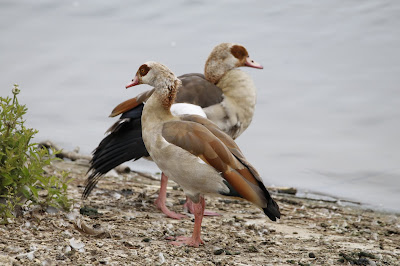July can be a tedious time to go bird watching, when even the main sites can seem quiet. The end of summer blends in to the start of Autumn, where everything is tired and yet to energise. So without great expectaions I headed down to Essex, to Abberton Resrvoir for a day's birdwatching.
For those reading from the future, this is still in the quasi-lockdown of the coronavirus, and a lot of places are still closed. This includes the centre and hides at Abberton, so all the birdwatching was done from the causeways, where access is still allowed, but viewing can be limited.
Pair of EGYPTIAN GEESE
First port of call was Layer de la Haye causeway, which looks over the main reservoir at the hide bay. There were large numbers of birds present on the water, but they were mainly GEESE and SWANS, birds moulting on the reservoir.
A scan of the area produced a GREAT WHITE EGRET, on a spit of land, towering over the nearby CORMORANTS, as they dry out their wings.
Feeding on the concrete banks were two COMMON SANDPIPERS which were disturbed and flew off with that distinctive jerky flutter of their wings. In the end they would prove to be the only waders present at Abberton. These birds aren't really waders in habit, instead they feed on insects which are attracted to the warm sun traps of the concrete sided causeway. As their name suggests they are common birds, passing through on their Autumn migration.
Also of note, but not a bird, was a BROWN HARE, on nearby farmland beyond the causeway, a common mammal I know, but one I always love seeing.
Hide Bay, Abberton Reservoir
After Wigborough, the next destination was the Layer Breton causeway, which slices through a smaller section of reservoir than the previous causeway. The area here is more natural, with trees straddling the banks. There were also hordes of loitering GEESE, waiting to be fed, and fed they were, as I was there several families turned up with bread in hand. Oh well if it gets the kids interested in wildlife I can't complain.
Also present were several hundred DUCK, mainly GADWALL, POCHARD and TUFTED DUCK, the first of what would be a large number of moutling ducks. As the ducks moult their flight feathers they cannot fly, which means they choose large deep reservoirs to spend their time, free of predators. This occurs in late summer and happens only on the large areas of water, but on those it happens it creates a great sight. The main challenge with birding ducks in moult is the the fact that all the ducks are brown in plumage, which makes them all look the same! The challenge is in trying to tell the birds apart by their shape and subtle differences of plumage.
Also from here I saw another GREAT WHITE EGRET, Abberton is a good site for them.
Mercea Island
With time to spare, I decided to take, for me, the road less travelled, by going to a place I've never been to before: Mercea Island. Travelling this area of Essex, its very leafy, unspoilt countryside, what you don't expect from this neck of the country. I travelled across the causeway and onto the island, the tide was well and truly in. I took the road to the east of the island where I hit the coast. There is a National Nature Reserve here, on the mudflats, so I thought I could do some birding here.
However, the tide was in and I felt very overdressed, bins, scope and camera to what was a beach crawling with people and no birds at all.
Abandoned boat, West Mercea
I walked along the coast to Cudmore Grove, your usual kind of country park, meadow, tree plantations, heaving with people, not really of interest to me, but its somewhere asking to be explored.
After this I headed over to West Mercea, which is built up, a one bank town, with cafes and another small beach. Nice to explore, but in the end not a place I will go back to again.
So in the end it was a good day out to an area I do not know well at all and it felt good to have expanded my horizons. The only problem is there are just too many places to visit and to know well.
Writing this blog I look forward to the heady days of Autumn, when birdwatching steadily ramps up to create a much greater experience. At the moment its just a trickle of waders that marks out the Autmtumn migrants, it feels slow, but soon as more birds have finished raising young it will turn into a torrent, and in no time it will soon be winter again. Such is the cyclical nature of the seasons.
Writing this blog I look forward to the heady days of Autumn, when birdwatching steadily ramps up to create a much greater experience. At the moment its just a trickle of waders that marks out the Autmtumn migrants, it feels slow, but soon as more birds have finished raising young it will turn into a torrent, and in no time it will soon be winter again. Such is the cyclical nature of the seasons.




No comments:
Post a Comment